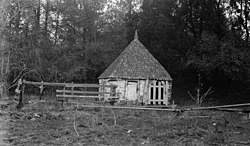Denbigh Plantation Site
Denbigh Plantation Site | |
 Denbigh Plantation springhouse in the 1930s | |
| Location | 10 Blacksmythe Ln., Newport News, Virginia |
|---|---|
| Coordinates | 37°5′24.3″N 76°32′20″W / 37.090083°N 76.53889°W |
| Area | 390 acres (160 ha) |
| Built | 1630 |
| NRHP reference No. | 70000873[1] |
| VLR No. | 121-0008 |
| Significant dates | |
| Added to NRHP | February 16, 1970 |
| Designated VLR | December 2, 1969[2] |
Denbigh Plantation Site, also known as Mathews Manor, is a historic archaeological site located at Newport News, Virginia.
History[edit]
Mathews Manor was built about 1626 for Captain Samuel Mathews. The post-medieval Mathews Manor included a projecting porch and center chimney, both characteristic of Virginia's earliest substantial dwellings. Mathews's house burned about 1650 and was replaced with a smaller house nearby, probably by his son, Samuel Mathews, Jr. (1630-1660), governor of Colonial Virginia (1656-1660). His grandson, John Mathews, b. 1659 is known to have lived at the home as a child, until receiving a patent on 9 March 1678 for 2944 acres on Deep Creek about 2 miles south of this location, which would become a plantation known as Blount Point. It is recorded that on 24 Jun 1679, a William Cole was serving as guardian for the young John Mathews.
By the mid-18th century, it was owned the Digges family, first by Cole Digges, whose first name reflects his mother's Cole family. The Digges family referred to the property as Denbigh plantation and constructed a manor house nearby. Family members also owned Boldrup plantation in Warwick county as well as plantations in York County. Cole Digges and William Digges represented Warwick County as burgesses (and Cole Digges served on the Virginia Governor's Council) before the American Revolutionary War, and William Digges Jr. (who married one of his uncle's daughters) served in the a revolutionary convention and in the Virginia House of Delegates after he sold Denbigh plantation in 1787. His brother Cole Digges also served in the Virginia Ratification Convention.[3] Richard Young is recorded as owning the planation in 1882, when he granted prior glebe land to a church in the area.[4]
Modern times[edit]
As the Newport News area developed in the early 20th century, part of Denbigh was sold to Mennonites, who continued to farm the land, as well as constructed a dairy and began residential development. Following World War II, Warwick County was reincorporated as Warwick City in 1952, then merged into the City of Newport News in 1958. Many former plantations became residential developments and/or industrial parks, but archeological research conducted first. Colonial Williamsburg's renowned archeologist Ivor Noël Hume excavated the Denbigh Plantation Site during the 1960s. His findings revealed much about early domestic life in the Virginia colony. In addition to the manor house, the site also includes several 17th-century industrial sites and the archeological remains of the 18th-century home of the Digges family. The foundations of both the Digges and Mathews houses have been capped and delineate their outlines, one with a historical marker in a small park at 10 Blacksmythe Lane. An 18th-century dairy and early 19th-century kitchen associated with the Digges homestead are still standing. The earliest known porcelain in Virginia, as well as other early artifacts, were found here during excavation. Although now surrounded by residential development, these sites are preserved within neighborhood parks.[3]
It was listed on the National Register of Historic Places in 1970.[1]
References[edit]
- ^ a b "National Register Information System". National Register of Historic Places. National Park Service. July 9, 2010.
- ^ "Virginia Landmarks Register". Virginia Department. Retrieved May 1, 2023.
- ^ a b "A National Register of Historic Places Travel Itinerary, James River Plantations: Denbigh Plantation Site". National Park Service.
- ^ Shanks, Mark Lee (1982). The History of Denbigh Baptist Church.
External links[edit]
- Denbigh Plantation, Milk House, Lukas Creek Road, Newport News, Newport News, VA at the Historic American Buildings Survey (HABS)
- Denbigh Plantation, Spring House, Lukas Creek Road, Newport News, Newport News, VA at HABS




